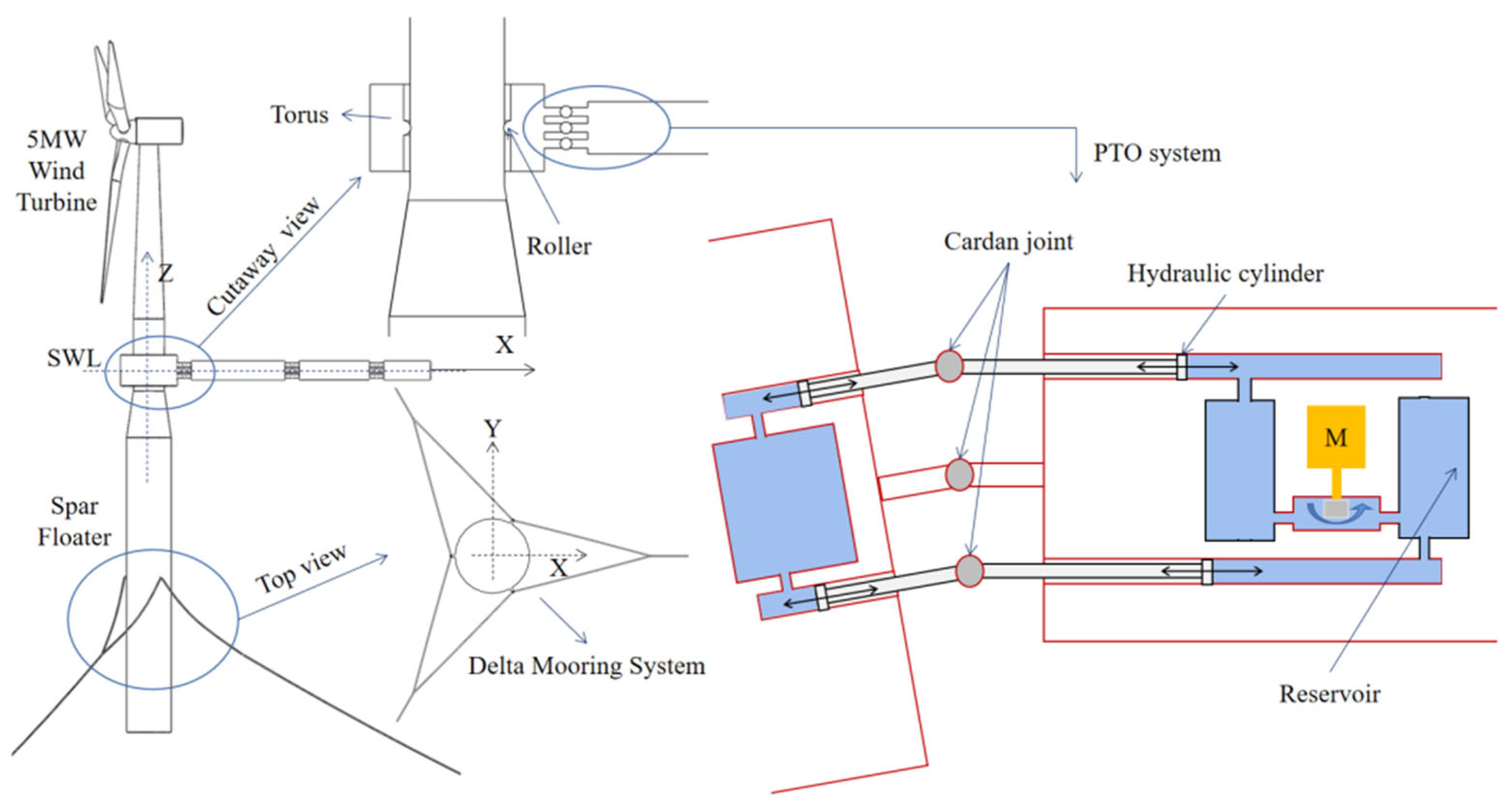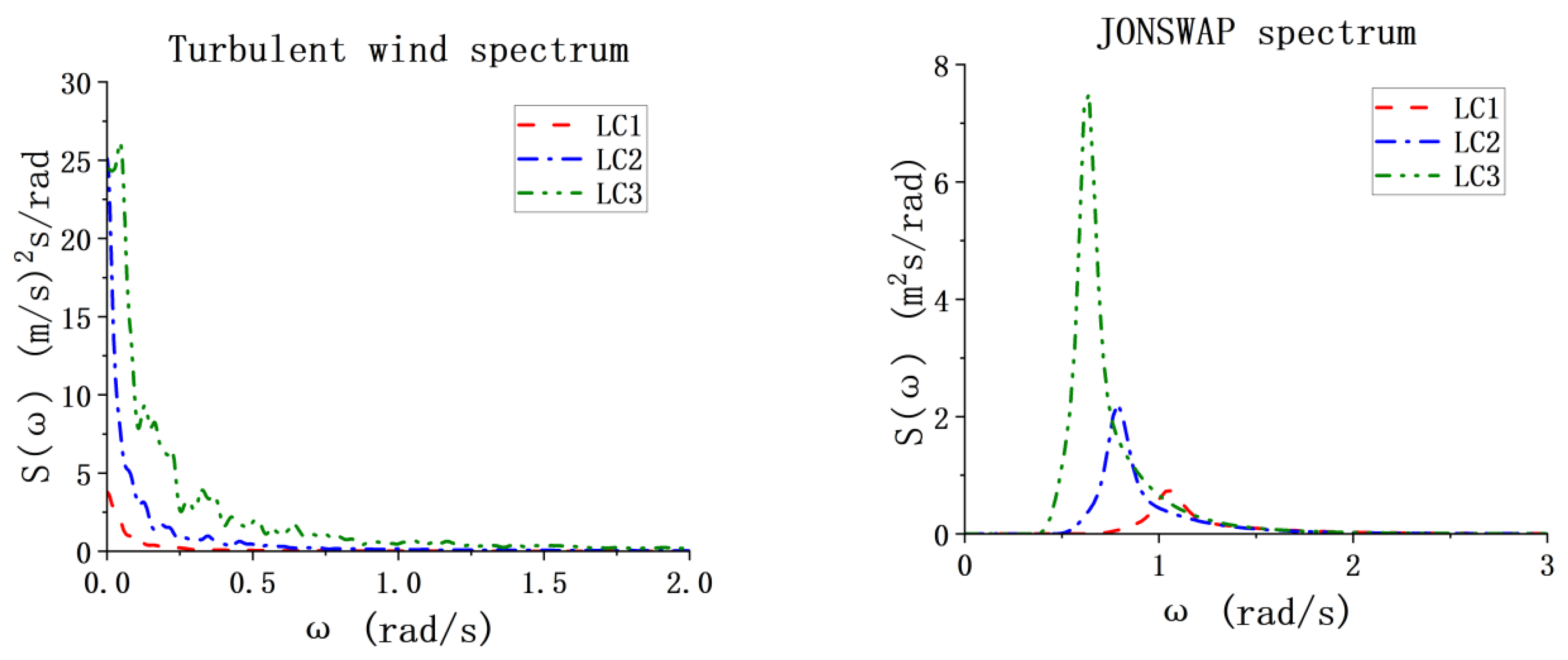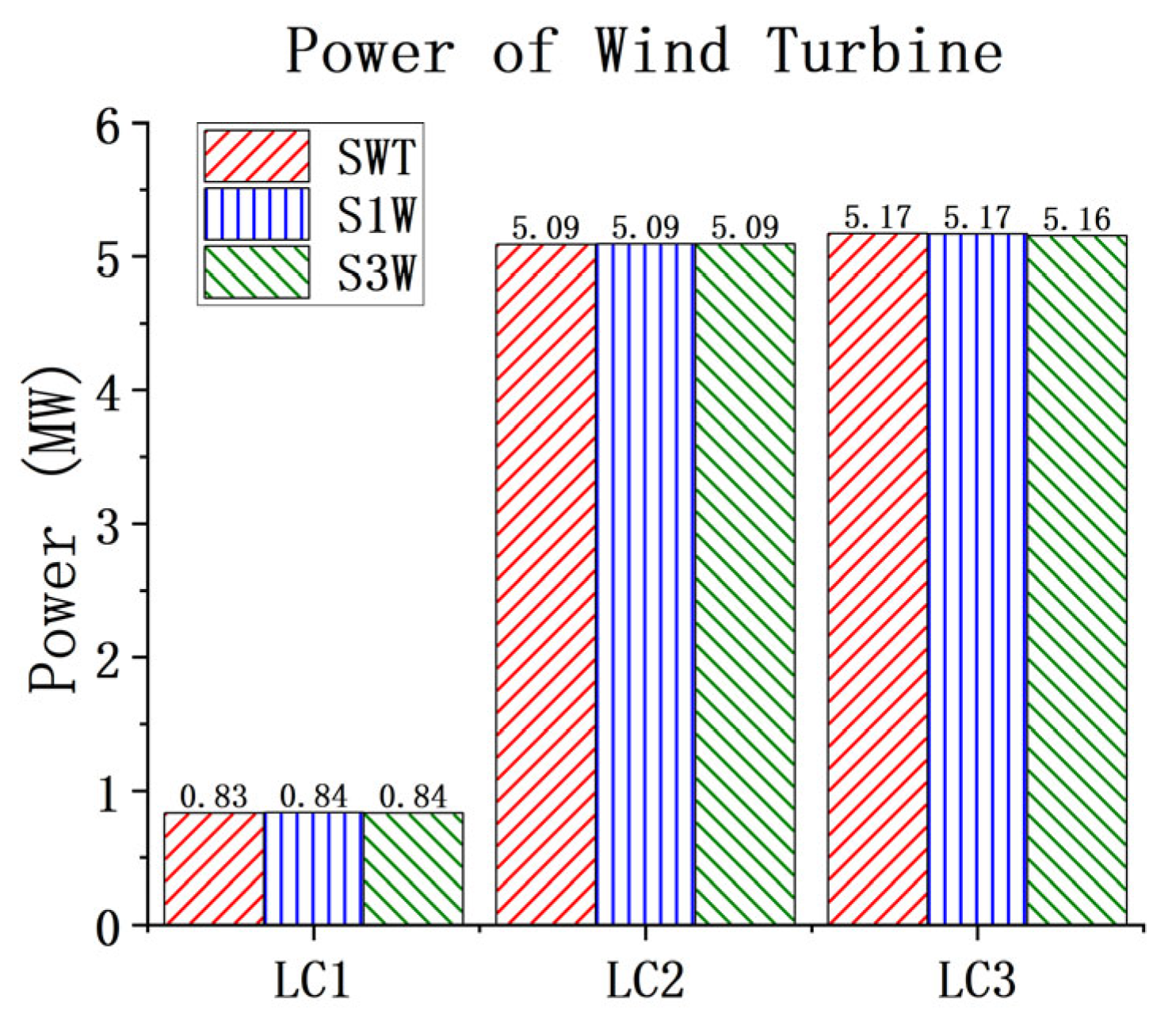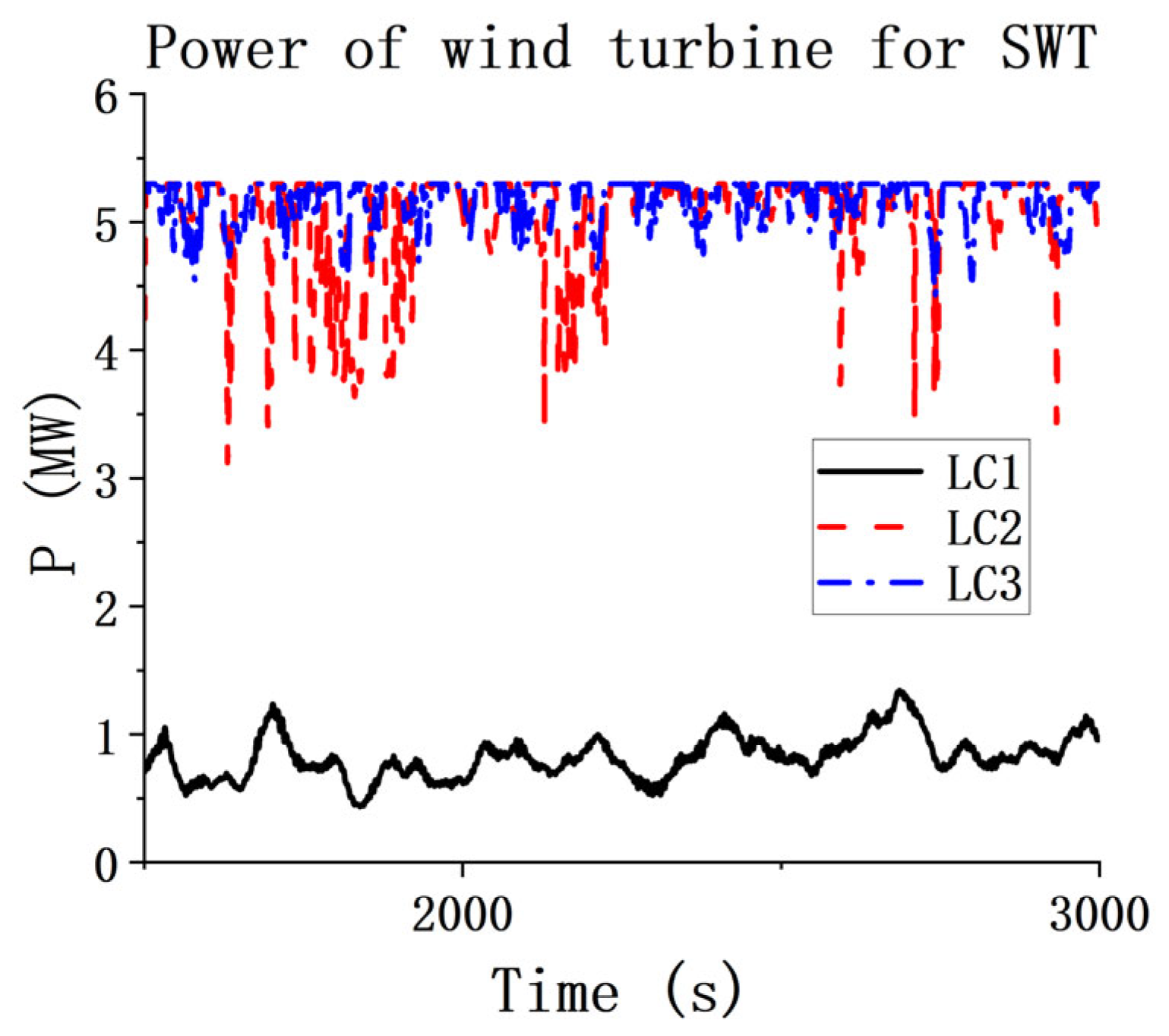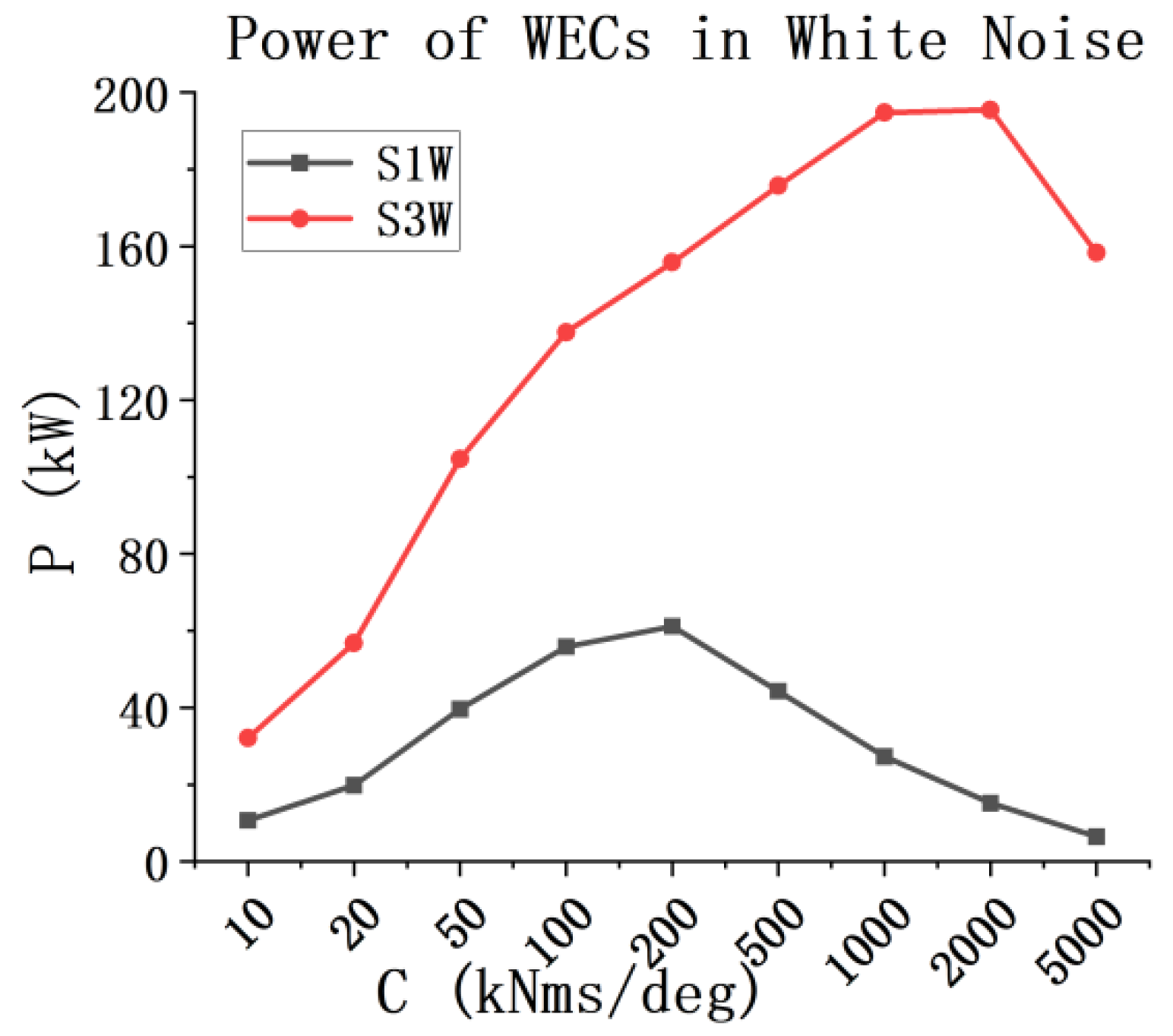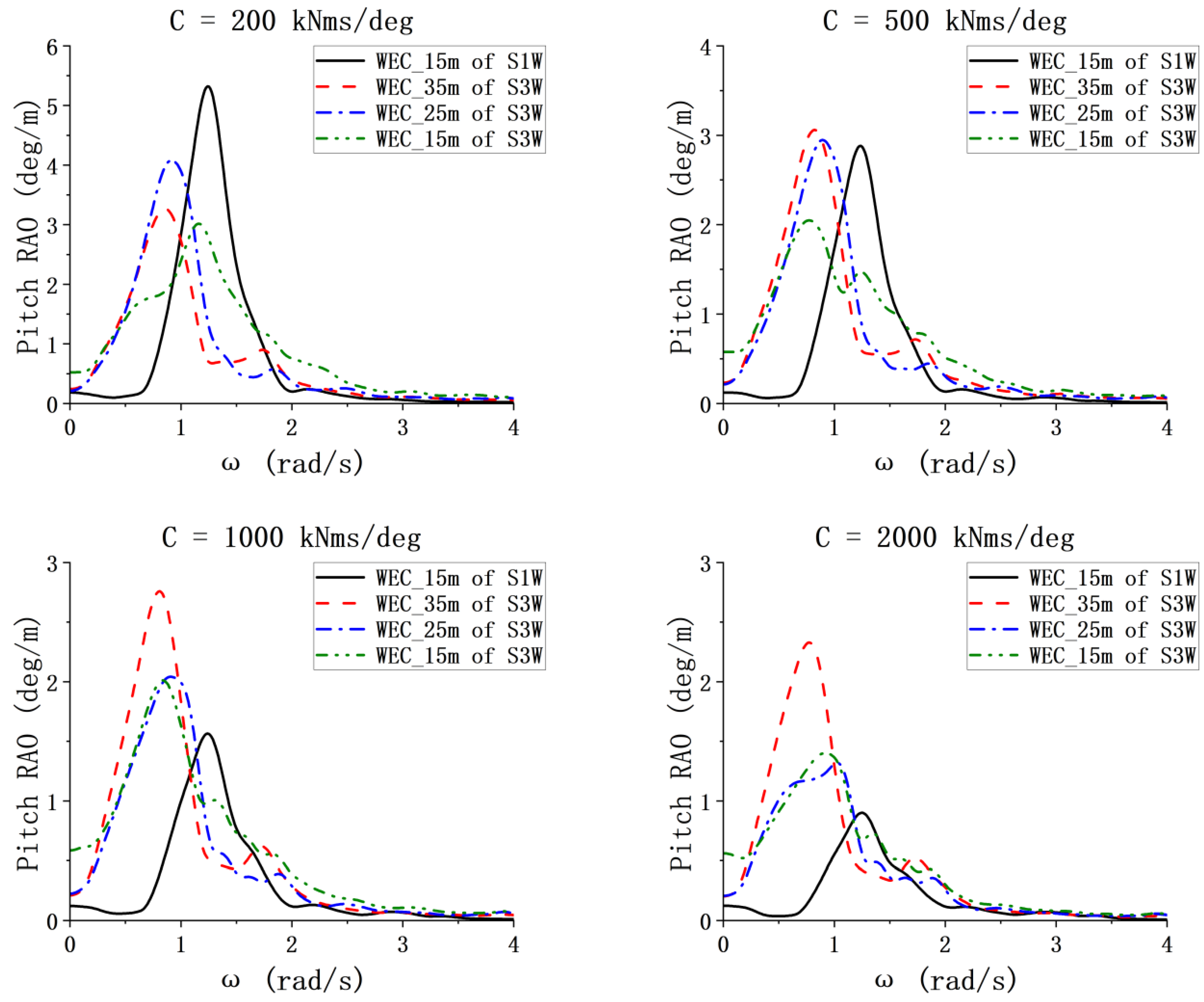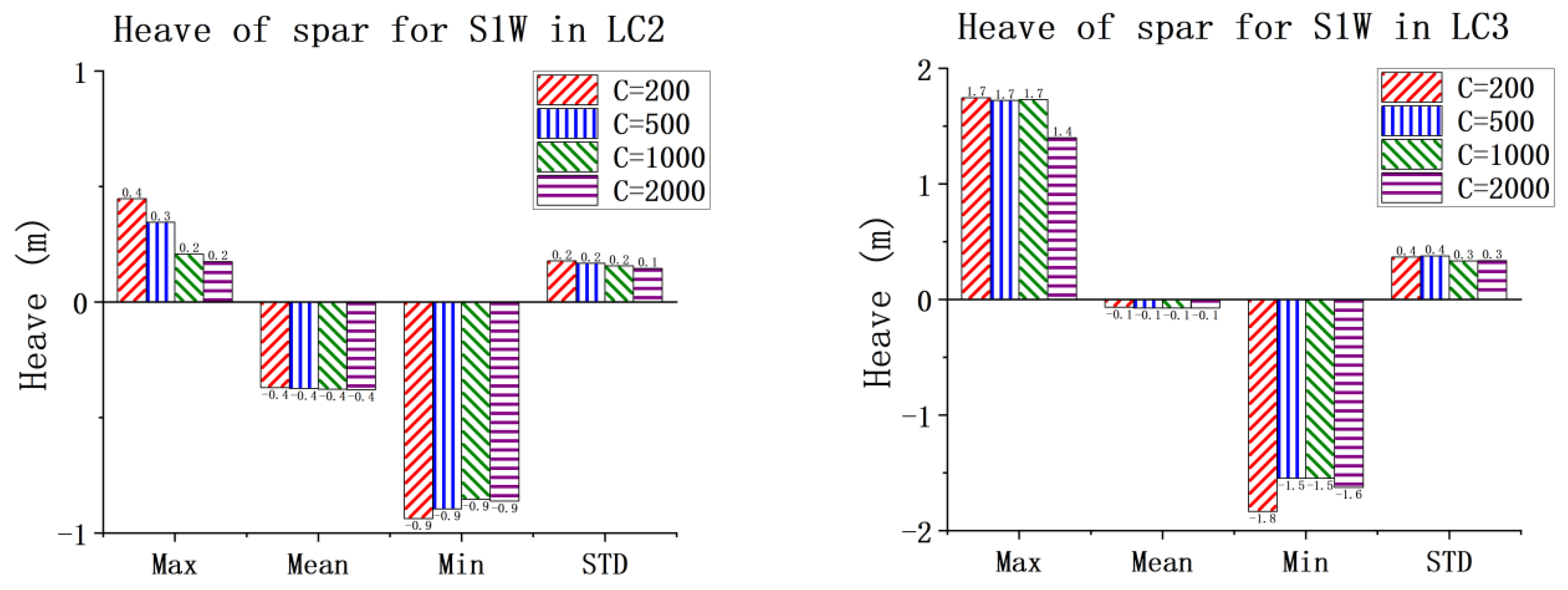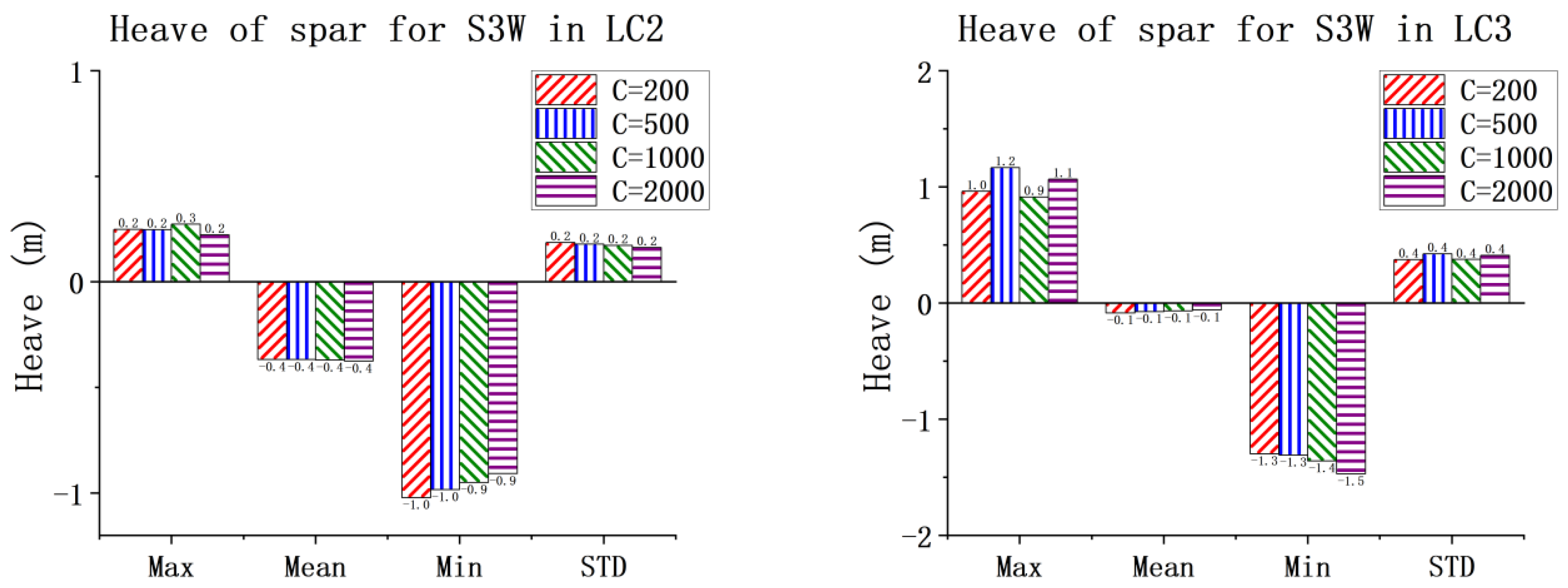1. Introduction
Under the Paris Agreement’s mandate for carbon neutrality by 2050 [
1], the development of offshore renewable energy has emerged as a critical pathway for achieving decarbonization. Among offshore renewable energy, wind and wave energy both represent energy types with plentiful resources. The rapid development of offshore wind energy has led to advancements in floating platform designs, including barge-type, semi-submersible, spar, and TLP configurations. Over the past 15 years, there has been a significant increase in the size and power capacity of these floating wind turbines, from 2 MW to 20 MW capacity scale [
2]. Concurrently, various concepts of WEC, such as oscillating water column (OWC), oscillating body systems, and overtopping converters, have been developed.
Offshore wind energy has almost achieved commercial viability through technological advancements. With offshore wind turbines progressively moving into deeper waters, where resources and space are more abundant, floating wind turbines provide better solutions compared with the bottom-fixed type in terms of economic and technological aspects. Nevertheless, the levelized cost of energy (LCOE) for floating wind turbines is still high, approximately 50% higher than that of onshore wind turbines, due to strict system requirements arising from complex environmental conditions and heavy infrastructure costs [
3]. Meanwhile, scholars such as Ali [
4] and Wang [
5] et al. also performed floating platforms optimizations to enhance platform stability and reduce costs. However, wave energy converters (WECs) are far from commercialization. The reasons are multifaceted. Currently, wave energy conversion technologies face challenges such as high costs, reliability issues, and technological immaturity. Compared to other clean energy installations, the energy absorption efficiency of WEC is low (less than 30% [
6]), and the absorption frequency bands are narrow and limited. The cost of infrastructure is very high, encompassing investments from research and development to operation and maintenance [
7]. Furthermore, reliability under long-term wave loading [
8] and adaptability to extreme sea conditions [
9] must also be considered. Therefore, most of the WEC concepts are still in the demonstration phases, exemplified by the Pelamis attenuator, the WaveStar WEC array, etc. These limitations underscore the necessities to combine wind and wave energy systems into one integrated system. Through the integration, capital expenditure of infrastructures can be reduced, and power capacity can be increased.
In recent years, technological advancements in hybrid wind–wave systems have demonstrated promising pathways for cost reduction and performance optimization. The European Union has been leading in supporting several initiatives aimed at fostering the development of multi-purpose platforms, including H2OCEAN [
10], MERMAID [
11], TROPOS [
12] and MARINA Platform Projects [
13]. In addition, scholars have also proposed WINDFLOAT [
14] and REFOS hybrid projects [
15]. The TROPOS project explores four key areas—transport, energy, aquaculture, and leisure—exploring the synergies that can be achieved by combining these functions on a single platform [
16]. The MERMAID project conducts a comprehensive analysis of the policy, economic, social, technical, environmental, and legal aspects of multi-purpose platforms across diverse locations [
17,
18]. The H2OCEAN project aims to create a combined wind-wave energy platform, capable of producing hydrogen, catering for diverse energy applications. The WINDFLOAT project aims to produce clean hydrogen using floating wind turbines in offshore wind farms as platforms. The MARINA Platform Project and the REFOS hybrid projects, in particular, were focused on the integration of offshore wind and wave energy into the mixed energy system. These projects highlight the potential of multi-purpose platforms in enhancing energy capture efficiency and dynamic stability.
There have been many combined wind–wave energy converters proposed and studied in recent years. One notable example is the Spar-Torus Combination (STC) [
19] proposed by researchers at NTNU, which combines a spar-type floating wind turbine with a heave-type torus WEC. Through numerical simulations and wave tank experiments, Wan et al. [
20,
21] demonstrated that the STC concept exhibits favorable dynamic performance under both operational and extreme conditions, with the WEC contributing to additional energy capture while minimally affecting platform stability. Michailides et al. [
22,
23] introduced the combined concept of SFC (Semi-submersible Flap Combination), which consists of a 5 MW semi-submersible wind turbine and three flap-type wave energy converters. Their studies confirmed that the flaps not only enhance power output but also reduce platform motions under extreme sea conditions. Ren et al. [
24] studied a combined wind–wave energy device consisting of a tension-leg platform (TLP) and a heave-type wave energy converter, where a heave-type WEC was found to increase total power generation while maintaining structural stability. Besides, there are other innovative designs. Homayoun et al. [
25] investigated a combined system of a 5 MW semi-submersible wind turbine and three heave-type point absorbers, known as the SWWC. The simulation results showed a complementary relationship between wind and wave energy systems, which is a synergistic effect where wave energy compensates for wind intermittency. Zhang et al. [
26] and Jin et al. [
27] explored combinations of the DeepCwind floating turbine with Wavebob and Wavestar WECs, demonstrating that WECs can enhance platform performance without compromising stability. Kim et al. [
28] analyzed the motion responses of wave-wave combined energy platforms with and without wave energy converters (WECs) through numerical modeling and wave tank tests. Rony et al. [
29,
30] successively conducted coupling dynamic analyses on the hexagon-shaped Frustum Tension-leg platform (FTLP) and three other types of offshore floating platforms, all of which supported a 5 MW wind turbine and were combined with various wave energy converters (WECs). These studies have enabled us to further understand the structural integrity, power performance and dynamic response of the floating wind energy platform in combination with WECs. Wan et al. [
31] provided a comprehensive review of the technical development of combined wind–wave energy conversion systems, proposing a novel categorization method that identifies dynamic response characteristics based on the working principles of offshore wind turbines and wave energy converters. It was also highlighted that multi-body WECs in the combined system, which mitigate dynamic responses and amplify total power output, seem to be promising for achieving synergies. This suggests that future designs should focus on the multi-body WEC arrangement and optimizations to maximize synergies between wind and wave energy capture.
Although the proposed wind–wave combined systems have demonstrated that relatively reduced costs and increased energy output can be achieved, most of them obviously accommodate WECs that resonate within a single or narrow frequency band, i.e., WECs, and are designed to capture wave energy within a specific frequency band. With the aim to achieve multi-band or broad-band energy absorption within frequencies, a novel combined wind–wave energy converter is proposed in this work. This system combines a spar-type floating wind turbine with multi-section pitch-type wave energy converters, inspired by the ‘Pelamis’ concept [
32]. However, unlike the ‘Pelamis’, the pitch-type WECs have different lengths in the proposed concept, targeting different resonant frequencies. They are connected to each other in series by a power take off (PTO) system. The first WEC is connected to the cylinder of the spar by a heave-type torus, with the aim to allow the relative yaw motions to make the WECs weather-vaned and to minimize the coupling effects between the wind turbine and WECs.
The aim of this paper is to investigate the dynamics of the proposed concept and explore the potential advantages and synergies of the combined concept. This paper is organized as follows:
Section 2 describes the proposed concept;
Section 3 introduces the theories and methodologies applied in this study;
Section 4 provides the numerical modelling, verification study, and the simulation load cases; the results, discussions, and analysis are provided in
Section 5. The conclusions are drawn in
Section 6.
2. Concept Description
In this study, OC3-Hywind spar [
33] is selected as the floating platform, supporting the NREL 5 MW baseline wind turbine [
34]. We refer to it as the spar wind turbine or SWT for short. In SWT, the delta mooring system is designed to provide additional yaw stiffness. Taking SWT as a platform, pitch-type WECs are attached to it, through a torus. In this combined concept, the WECs are connected through a rotational hydraulic power take-off (PTO) system. Relative motions in the pitch and yaw degrees of freedom (DOF) are allowed, but with an end-stop system to prevent excessive relative motions. The relative rotations drive PTO rods to actuate hydraulic cylinders, then generate electricity using high- and low-pressure tanks, as depicted in
Figure 1. In surge, sway, heave and roll DOFs, they are restrained through mechanical couplings. It is noted that the WECs are connected to each other in series and are designed with different lengths, with the aim to achieve resonance at different wave frequencies and multi-band absorption. A torus is installed along the spar cylinder and is also used to connect the first WEC to the SWT. The relative yaw motions of the spar and the torus are allowed, to achieve the “weather-vane” feature of the WEC system, so that the WECs face the varying incoming wave directions.
To investigate the single-WEC and multi-WEC effects on the combined concept, two combined concepts are studied here. As shown in
Figure 2. The first combined concept includes one-section WEC, with the length of 15 m, referred to as S1W for short; the second combined concept includes three-section WECs, with lengths of 35 m, 25 m and 15 m respectively, referred to as S3W for short. The coordinate system is at the still water line, with the origin located at the spar cylinder center, and the positive
x-axis points to the longitudinal direction of the WEC.
The draft of the OC3-Hywind spar floating platform is 120 m. The tower is located at the top of the floating platform, which is 10 m above the SWL. The more detailed platform properties are presented in
Table 1, and more information can be found in [
33]. It is noted that the moments of roll and pitch inertia (Ixx and Iyy) are calculated relative to the center of gravity, and the moment of yaw inertia (Izz) is calculated relative to the platform centerline. A 5 MW NREL reference wind turbine is used here, and detailed information can be found in [
34].
The torus dimensions and WEC dimensions are presented in
Table 2. The WECs in series have different lengths, i.e., 35 m, 25 m and 15 m, respectively. Their masses and moments of inertia are also different, and the radii of gyration are calculated with respect to their own centers of gravity. The ‘delta-type’ mooring system properties are given in
Table 3. The SWT, S1W and S3W models all use the same mooring system. One of the mooring lines is aligned with the positive
x-axis, with the other two evenly distributed at 120° and 240°.
3. Methodology
In the present study, potential flow theory is used in the frequency domain to calculate the hydrodynamic characteristics of the floaters. Panel models for both the spar and the WECs, based on potential flow theory, are employed to compute the hydrodynamic properties. The hydrodynamic loads in the frequency domain are determined using first-order calculations, and the mean wave drift forces are calculated. Hydrodynamic interactions between multiple bodies are considered.
To accurately capture the important nonlinear effects from wind turbine loads and the control, viscous effects on the floaters and mooring system, and the nonlinear forces in PTO systems, it is essential to perform time-domain calculations. Frequency-domain hydrodynamic parameters can be transferred to the time domain using retardation functions [
35]. For slender bodies, where diffraction effects are often considered insignificant when the diameter is less than one-fifth of the wavelength, the Morison formula provides a practical approach, accounting for viscous effects in this work. Therefore, the Morison equation is used to consider the viscous effects on the cylinders of the spar and the WEC, focusing solely on the viscous term, while inertia effects are inherently included in the panel model. In the time domain, the hydrodynamic model used is linear and does not account for strong nonlinear effects such as water entry and exit. The time-domain motion dynamic equation is expressed as in Equation (1) [
36]:
where
is the added mass matrix of the floater at infinite frequency;
,
and
are the displacement, velocity and acceleration vectors in the time domain, respectively;
is the quadratic viscous damping coefficients matrix;
is the hydrodynamic excitation forces in the time domain;
is the retardation function matrix caused by the wave memory effects.
is the hydrostatic restoring matrix provided by the mooring system.
Additionally, the S1W and S3W models must account for the hydrodynamic coupling effects. Taking S1W as an example, there are three rigid bodies, namely the spar, torus, and WEC floater. The motion equations have 18 degrees of freedom. Considering the aerodynamic forces acting on the floating wind turbine and the mechanical coupling force between the rigid bodies, Equation (1) can be rewritten as [
20]:
where the subscripts 1 and 11 represent the variables of body 1 (spar), 12 and 21 represent the coupling variables between body 1 and body 2 (torus), and the remaining subscripts follow the same logic;
is the thrust of the wind acting on the spar, which is calculated as a drag force;
is the hydrodynamic excitation forces in the time domain;
is the mechanical coupling term between the two bodies, where,
and
. Take
as an example, and it can be written as
where
is the coupling damping coefficient matrix between body 1 and body 2, and
is the coupling stiffness coefficient matrix between body 1 and body 2.
The aerodynamic load of the wind turbine is typically determined using the blade element momentum (BEM) theory [
37], which combines blade element theory and momentum theory, and is crucial for analyzing and optimizing the energy and aerodynamic performance of turbine blades. Momentum theory incorporates the principles of conservation of linear and angular momentum. By dividing the rotor into ‘n’ circular elements, the forces on each element are calculated, then the aerodynamic forces are calculated based on integration. In BEM theory, the forces on each element are derived using lift (
CL) and drag (
CD) coefficients, with the lift force
dL and drag force
dD expressed as [
38]
The power coefficient (
Cp) [
39] can be calculated by using Equation (6):
where
is the shaft power output in Watts and
is the upstream undisturbed wind speed in m/s.
The wave power is extracted through the relative motions between different bodies. The motion referred to here is rotation. Therefore, the instantaneous absorbed wave power [
40,
41] generated by the motion of the WEC can be expressed in the form of Equation (7):
where
is the instantaneous power (in kW) on a rotational flex joint of the WEC;
C is the rotational damping coefficient (in KN·ms/deg) of the rotational flex joint;
M is the rotational moment (in kN·m) of the rotational flex joint;
is the relative angle (in deg) of pitch between two adjacent floating bodies;
is the relative angular velocity (in deg/s) of pitch between two adjacent floating bodies. It is noted that the current investigation excludes the yaw motions between adjacent floating bodies and the energy that might be generated. Additionally, the impact of rotational stiffness between adjacent floating bodies on the motion and power generation performance is not accounted for, and its value is assumed to be small.
For the model with three-section WECs, three PTOs are designed. The first PTO is taken as the joint connecting the torus and the first WEC, and the power in the first PTO is denoted as P1; the second PTO connects the first WEC and the second WEC, and the power is denoted as P2; the last PTO connects the second and the third WEC, and the power is denoted as P3. Then, the total power (Pt) of three-section WECs is calculated as P1 + P2 + P3. In order to quantify the power performance index of the WECs in the combined concepts, the term capture width ratio (
CWR) is used.
CWR [
42,
43] is defined as the ratio of the power
P (in kW) converted by the WEC to the available wave power
J (in kW/m) and the characteristic dimension
D (in m) of the WEC per unit wave front:
The
CWR (in %) is considered as the wave crest width that is fully captured and absorbed by the WEC. The wave resource
J is wave power flux [
44,
45] and represents the wave power available per meter of wave crest width. The wave power flux in deep water can be calculated using Equation (9):
where
Hs is the significant wave height;
Te is the energy period, 1.12
Te=
Tp; and
Tp is the peak period of the JONSWAP spectrum.
6. Conclusions and Prospects
This study introduces a novel combined concept that combines a spar-type floating wind turbine with a multi-section pitch-type wave energy converter (WEC), referred to as S1W or S3W, depending on the number of WEC floating bodies. The WEC is attached to the spar column and consists of multiple sections with different WEC lengths to absorb wave energy across multiple frequency bands. The torus serves as the connection between the WEC and the spar, allowing for free heave movement to reduce the spar motion influenced by the WEC, while constraining the relative horizontal motion between the spar and the torus. The design also includes a weather-vane capability.
This study confirms the synergistic design of the WEC through simulations. It demonstrates that the existence of WECs has little impact on the overall dynamic response of the spar wind turbine and has only a certain influence on the heave motion. Through the comparison and analysis of the total power for the one-section WEC and the three-section WEC with different PTO damping conditions under white noise, the optimal PTO damping range is determined. The given results indicate that the total power of the three-section WEC is always greater than that of one-section WEC. The pitch RAO results of the WEC floating bodies for S1W and S3W are also obtained. Differences in the pitch natural frequencies of different WEC floating bodies are identified. This observation indicates the potential of multi-band energy absorption for the three-section WEC.
The PTO damping condition has little effect on the motion responses of the spar wind turbine but has significant impacts on the pitch motions of the WECs. As PTO damping increases, the amplitude of WEC pitch clearly decreases, with the exception of WEC_15 m in the S3W model. Under low sea states, the average power of the three-section WEC is lower than the total power of the one-section WEC. However, as the sea state and PTO damping increase, the average power of the three-section WEC increases significantly, indicating that under optimal PTO damping, the energy absorption capability of the multi-section WEC is greatly enhanced. The CWR results of the WECs also confirm this conclusion. The power spectrum results also confirm the multi-frequency energy absorption capability of the three-section WEC. In general, by the comprehensive analysis of the dynamics of the combined concepts, particularly under the three operational conditions, it reveals that the dynamic responses are within a reasonable range. This observation indicates the feasibility of the proposed concepts.
Moving forward, the intricacy of the combined concept necessitates additional research efforts. For instance, the accuracy of the numerical model should be further confirmed through experimental model testing, and the dynamics of the combined concept under extreme environmental conditions needs to be examined. Moreover, the design and optimization of the WECs, including the number and dimensions of the floating bodies, as well as the selection of rotational stiffness and damping coefficients for different joints, will play a critical role in enhancing multi-band absorption. Additionally, implementing adaptive damping control that responds to environmental fluctuations could be key to optimizing the efficiency of wave energy capture.
